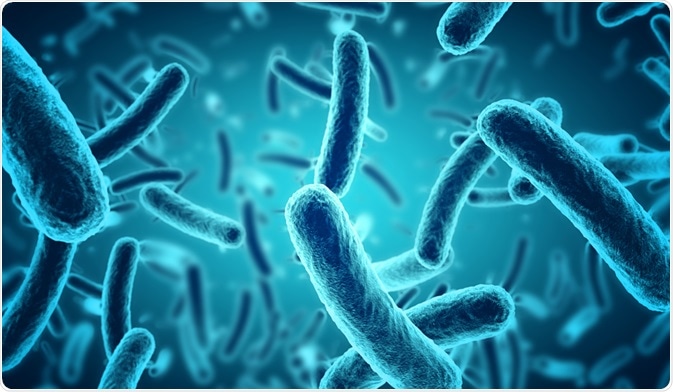Gregory D. Poore and his research group from the University of California have found unique microbial signatures in major classes of cancer. These are predictive for patients with stage Ia–IIc cancer and cancers, and microbial DNA was sufficient to distinguish between cancer-free individuals and patients with multiple types.
 Image Credits: paulista / EurekAlert.com
Image Credits: paulista / EurekAlert.com
The authors suggest that these microbial DNA and RNA signatures could present a novel diagnostics methodology that augments existing diagnostics tools in the clinical setting.
Growing evidence suggests that microbial signatures are present in tumors surrounding organs and circulation. While the gut microbiome has been the most extensively studied in relation to gastrointestinal cancers, other microbial contributions to different cancers are less well understood.
Contaminants are the greatest limitation in the determination of this association. Recently developed tools have been used to minimize these and the team built on previous evidence to further identify and correlate multiple signatures of microbial DNA and RNA with human cancers.
Harnessing the power of artificial intelligence in the cancer context
The team used trained artificial-intelligence (AI) models applied to whole-genome and whole-transcriptome sequencing studies in The Cancer Genome Atlas (TCGA). AI-models enabled filtering and accurate classification of microbial nucleic acids derived from samples. These TCGA blood signatures represent a potential oncology diagnostics tool based on microbiomes.
The group analyzed data obtained from over 17,000 samples taken from 10,000 patients, covering 33 cancer types. The cancer subtypes included primary, as well as recurrent tumors arising from metastatic spreading.
In addition to artificial intelligence-based models, the group used stringent approaches to filtering data to account for contaminant sequences and poor metadata quality (i.e. lacking data labels).
Of the 6.4 × 1012 sequences, 7.2% were categorized as non-human, with over one third classified as bacteria, archaea, or viruses. More accurate classification enabled a 12.6% single-genus level classification.
The team further tested each independently trained models’ ability to differentiate between cancer types and stages within each cancer. The machine-learning models could also distinguish between tumors and normal tissues.
Of the artificial intelligence-based model’s distinguishing capabilities, the model performed the best when distinguishing among types of cancer and between cancer patients and healthy controls. However, the model showed variable success in distinguishing between stage I and stage IV cancers.
Biological relevance to cancer
To address whether microbial signatures were indicative of cancer types and stages, the group trained an algorithm based on samples obtained from the Human Microbiome Project 2 (HMP2).
Their data was concurrent with previous findings: Fusobacterium spp. was a microbial associate of gastrointestinal tumors. Moreover, viral associations were uncovered, with the genus Alphapapillomavirus associated with HPV and Orthohepadnavirus associated with hepatocellular cancer
Artificial Intelligence can predict cancer types
Poore et al. used AI models to analyze whole genomes obtained from the TCGA cancer patient cohort. This microbial signature exploration revealed that blood-based microbial DNA (mbDNA) is a clinically relevant discerner of different cancer types, The group hypothesize that this is obtained from ‘leakage’ events in cancer progression.
As the team’s cohort only tested 69 healthy individuals and 100 patients with either high-grade prostate, lung or skin cancer, some limitations in these predictions were found. This necessities further validation of results in larger groups of patients.
The limitations of artificial intelligence
Poore et al. note that TCGA sample collection did not account for contamination – either by microbes or mbDNA. This is clinically important as contamination can occur at several opportunities spanning the stages of collection and sequencing.
Attempts to account for this included additional analysis on blood, the most contaminant-prone sample type, and very robust methods for contaminant filtering. This approach, however, comes at the expense of detecting the full microbial complement present in tumors.
Future studies are hoped to reveal the distribution and function of microbes in tumors and blood. While the group identified nucleic acid-based identification of microbial signatures, the origin of these microbes could not be ascertained.
Similarly, further research is necessary to determine whether these microbes are cancer-associated, or collaterally accumulated species whose persistence is supported by the altered tumor microenvironment.
A final opportunity for research lies in the mechanistic determination of microbial entry and persistence in cancer, in addition to targeting strategies for treatment and possible prevention.
Despite these limitations, the ability to associate microbial sequences using artificial intelligence in cancer and the subsequent prospect of manipulating the microbiome to drive clinical advances are promising.
Source
Poore et al. (2020) Microbiome analyses of blood and tissues suggest cancer diagnostic approach. Nature. DOI: 10.1038/s41586-020-2095-1
Further Reading
- All Microbiome Content
- The Human Microbiome Project (HMP)
- How Does the Diet Impact Microbiota?
- Achievements of the Human Microbiome Project
- Human Microbiome
Last Updated: Jun 5, 2020

Written by
Hidaya Aliouche
Hidaya is a science communications enthusiast who has recently graduated and is embarking on a career in the science and medical copywriting. She has a B.Sc. in Biochemistry from The University of Manchester. She is passionate about writing and is particularly interested in microbiology, immunology, and biochemistry.
Source: Read Full Article
